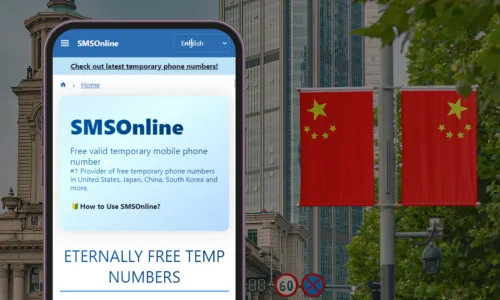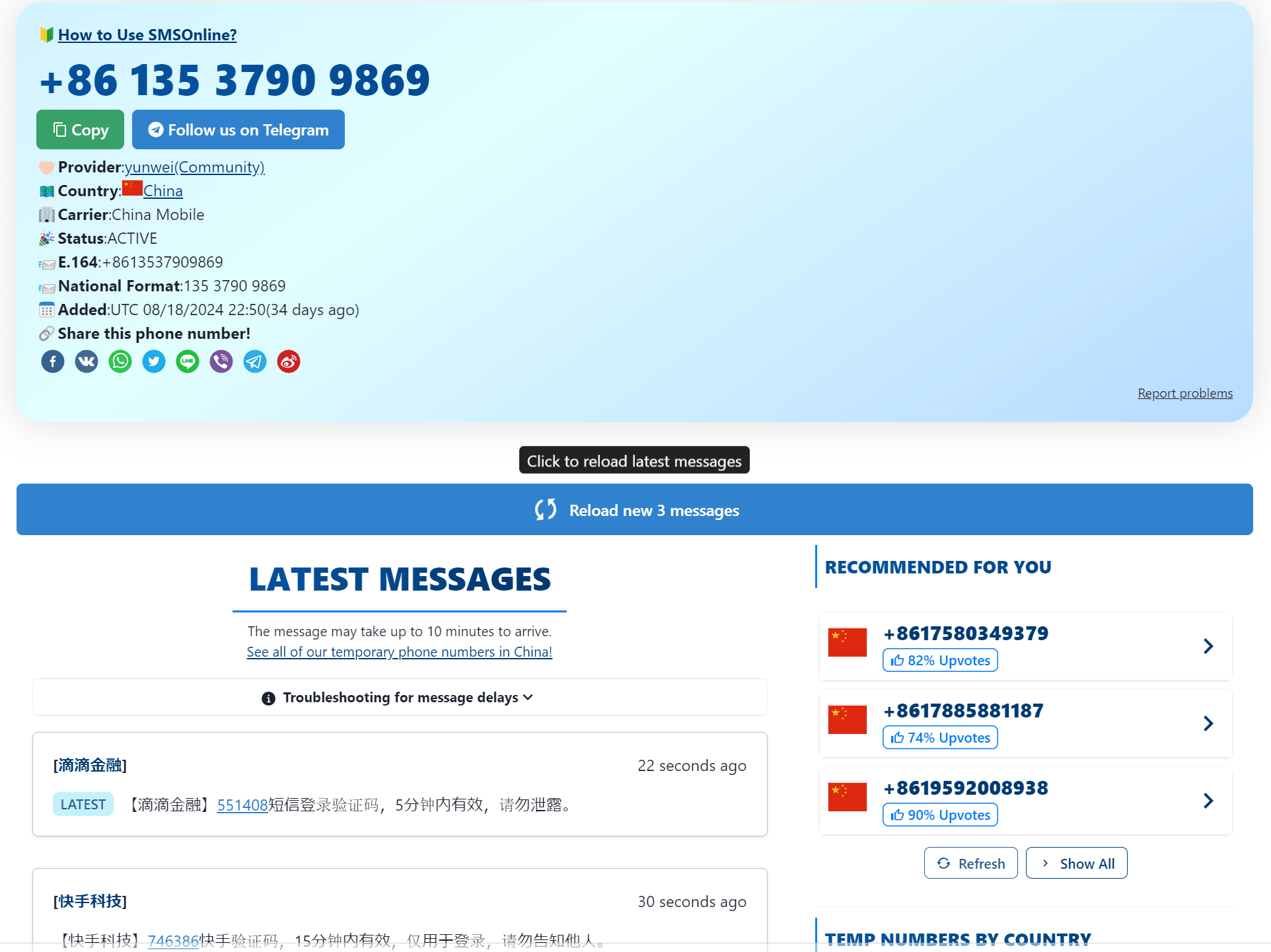
How to Identify the Origin and Carrier of a Call from a Chinese Phone Number?
Learn how to identify the carrier and area code of calls from Chinese phone numbers, including both mobile and landline numbers, plus tips for obtaining a number from abroad!
2024-10-030 minute readTips
Share
How to Identify the Area and Carrier from a Chinese Phone Number

The format of Chinese phone numbers is regulated by the Ministry of Industry and Information Technology (MIIT) of China. MIIT is a government agency responsible for formulating policies, regulations, and standards related to information and communication technology and telecommunications.
This article introduces how to identify the mobile carrier and area of a landline number from the current format of Chinese phone numbers, as well as a simple method for obtaining a Chinese phone number from abroad.
Role of MIIT
- MIIT determines the policies regarding the allocation of phone numbers within China by formulating the telephone numbering plan and the distribution of numbers among regions and carriers.
- International Phone Number Standards: MIIT manages the format of international calls from China, which includes the country code "+86".
- Number Portability: The rules and technical standards for migrating phone numbers are also established by this agency.
In this way, all regulations regarding the format and operation of phone numbers are determined by MIIT, and telecom operators and related organizations provide services based on these regulations.
History of China's Telephone Numbering System

Since the rapid economic growth at the end of the 20th century, the demand for mobile phones among the Chinese populace has surged.
As a result of this increased demand, the format of telephone numbers has been updated year by year as follows:
Before the 1980s: Landlines Only
- Telephone services in China were primarily provided through landlines, with number formats differing by city. Area codes were established, and varying lengths of phone numbers were used for different cities.
Late 1980s - 1990s: The Spread of Mobile Phones
- Early mobile phone numbers were 8 digits long and were used in combination with area codes, similar to landlines.
- By the late 1990s, as mobile phones became more widespread, the length of mobile numbers increased from 9 digits to 10 digits, accommodating the growing demand for communication.
1999: Standardization of Mobile Phone Numbers to 11 Digits
- In 1999, the Chinese government unified mobile phone numbers to 11 digits, alleviating the number shortage and addressing the surge in mobile phone users.
- Mobile phone numbers began with "1," followed by 2 digits to identify the telecom carrier. This 11-digit format is still in standard use today.
Early 2000s: Introduction of Number Portability
- The number portability system was introduced, allowing users to change carriers without altering their phone numbers. While this change did not impact the format of mobile phone numbers, it transformed the traditional notion of numbers being fixed to specific carriers.
2010s: Changes to Landline Numbers
- The area codes for landlines were revised, standardizing 10-digit numbers in major cities. For example, the area codes for Beijing and Shanghai were standardized to "010" and "021," respectively, with subsequent numbers standardized to 8 digits.
- In smaller cities and rural areas, 7-digit or 6-digit phone numbers are still in use, though efforts are being made to transition to 10-digit formats.
2019: Full Portability of Mobile Phone Numbers
- In November 2019, mobile number portability was introduced nationwide, enabling users to switch carriers without changing their mobile numbers.
- Early mobile phone numbers were 8 digits long and were used in combination with area codes, similar to landlines.
- By the late 1990s, as mobile phones became more widespread, the length of mobile numbers increased from 9 digits to 10 digits, accommodating the growing demand for communication.
1999: Standardization of Mobile Phone Numbers to 11 Digits
- In 1999, the Chinese government unified mobile phone numbers to 11 digits, alleviating the number shortage and addressing the surge in mobile phone users.
- Mobile phone numbers began with "1," followed by 2 digits to identify the telecom carrier. This 11-digit format is still in standard use today.
Early 2000s: Introduction of Number Portability
- The number portability system was introduced, allowing users to change carriers without altering their phone numbers. While this change did not impact the format of mobile phone numbers, it transformed the traditional notion of numbers being fixed to specific carriers.
2010s: Changes to Landline Numbers
- The area codes for landlines were revised, standardizing 10-digit numbers in major cities. For example, the area codes for Beijing and Shanghai were standardized to "010" and "021," respectively, with subsequent numbers standardized to 8 digits.
- In smaller cities and rural areas, 7-digit or 6-digit phone numbers are still in use, though efforts are being made to transition to 10-digit formats.
2019: Full Portability of Mobile Phone Numbers
- In November 2019, mobile number portability was introduced nationwide, enabling users to switch carriers without changing their mobile numbers.
- The number portability system was introduced, allowing users to change carriers without altering their phone numbers. While this change did not impact the format of mobile phone numbers, it transformed the traditional notion of numbers being fixed to specific carriers.
2010s: Changes to Landline Numbers
- The area codes for landlines were revised, standardizing 10-digit numbers in major cities. For example, the area codes for Beijing and Shanghai were standardized to "010" and "021," respectively, with subsequent numbers standardized to 8 digits.
- In smaller cities and rural areas, 7-digit or 6-digit phone numbers are still in use, though efforts are being made to transition to 10-digit formats.
2019: Full Portability of Mobile Phone Numbers
- In November 2019, mobile number portability was introduced nationwide, enabling users to switch carriers without changing their mobile numbers.
- In November 2019, mobile number portability was introduced nationwide, enabling users to switch carriers without changing their mobile numbers.
The last update was in November 2019, and the 11-digit phone number format established in 1999, along with the carrier-identifying prefix, is still in use today. However, with the rise of 5G and IoT devices, there is an anticipated increase in the demand for phone numbers, suggesting the possibility of extending the format to more than 12 digits.
Next, we will introduce methods to identify the telecom carrier and location using the current 11-digit phone number format.
How to Identify the Carrier of a Chinese Mobile Phone Number
Chinese mobile phone numbers are represented as (+86) 1XX-YYYY-ZZZZ.
+86 is the international code for China, 1XX is the prefix assigned to each telecom carrier, and YYYY-ZZZZ represents the individual user’s number.
The unique first three digits assigned to each carrier must start with "1," and as of October 2024, the allocations are as follows.
- Since 2019, China has implemented a mobile number portability system, allowing phone number owners to change their contracts to other telecom carriers without changing their numbers.
- Therefore, the carrier currently in use may not necessarily match the carrier identified from the phone number.
| Prefix | Carrier Name | Prefix | Carrier Name |
|---|---|---|---|
| 130 | China Unicom | 172 | China Mobile |
| 131 | China Unicom | 173 | China Telecom |
| 132 | China Unicom | 175 | China Unicom |
| 133 | China Telecom | 176 | China Unicom |
| 134 | China Mobile | 177 | China Telecom |
| 135 | China Mobile | 178 | China Mobile |
| 136 | China Mobile | 180 | China Telecom |
| 137 | China Mobile | 181 | China Telecom |
| 138 | China Mobile | 182 | China Mobile |
| 139 | China Mobile | 183 | China Mobile |
| 145 | China Unicom | 184 | China Mobile |
| 146 | China Broadcasting Network | 185 | China Unicom |
| 147 | China Mobile | 186 | China Unicom |
| 149 | China Telecom | 187 | China Mobile |
| 150 | China Mobile | 188 | China Mobile |
| 151 | China Mobile | 189 | China Telecom |
| 152 | China Mobile | 191 | China Telecom |
| 153 | China Telecom | 198 | China Mobile |
| 155 | China Unicom | 199 | China Telecom |
| 156 | China Unicom | ||
| 157 | China Mobile | ||
| 158 | China Mobile | ||
| 159 | China Mobile | ||
| 166 | China Telecom | ||
| 167 | China Broadcasting Network | ||
| 170 | MVNO (Mobile Virtual Network Operator) | ||
| 171 | MVNO (Mobile Virtual Network Operator) |
Let's aggregate the data for better readability:
- China Unicom: 11 entries
- 130, 131, 132, 145, 155, 156, 175, 176, 185, 186, 171 (MVNO)
- China Telecom: 11 entries
- 133, 149, 153, 166, 173, 177, 180, 181, 189, 191, 199
- China Mobile: 15 entries
- 134, 135, 136, 137, 138, 139, 147, 150, 151, 152, 157, 158, 159, 172, 178, 183, 184, 187, 188, 198
- China Broadcasting Network: 2 entries
- 146, 167
- MVNO (Mobile Virtual Network Operator): 2 entries
- 170, 171
To validate Chinese mobile phone numbers as shown in the table, you can use the following regular expression:
^1(30|31|32|33|34|35|36|37|38|39|45|46|47|49|50|51|52|53|55|56|57|58|59|66|67|70|71|72|73|75|76|77|78|80|81|82|83|84|85|86|87|88|89|91|98|99)\d{8}$
How to Identify Area Codes for Chinese Landline Numbers
For landline numbers, the area code can identify the allocated region.
Let's show this in a table as well (only showing the first part as there are many).
| Prefix | Region | Prefix | Region |
|---|---|---|---|
| 010 | Beijing | 0419 | Liaoyang (Liaoning Province) |
| 020 | Guangzhou | 0421 | Chaoyang (Liaoning Province) |
| 021 | Shanghai | 0427 | Panjin (Liaoning Province) |
| 022 | Tianjin | 0431 | Changchun (Jilin Province) |
| 023 | Chongqing | 0432 | Jilin (Jilin Province) |
| 024 | Shenyang | 0433 | Yanbian Korean Autonomous Prefecture (Jilin Province) |
| 025 | Nanjing | 0434 | Siping (Jilin Province) |
| 027 | Wuhan | 0435 | Tonghua (Jilin Province) |
| 028 | Chengdu | 0436 | Baicheng (Jilin Province) |
| 029 | Xi'an | 0437 | Liaoyuan (Jilin Province) |
| 0311 | Shijiazhuang (Hebei Province) | 0438 | Songyuan (Jilin Province) |
| 0312 | Baoding (Hebei Province) | 0439 | Baishan (Jilin Province) |
| 0313 | Zhangjiakou (Hebei Province) | 0451 | Harbin (Heilongjiang Province) |
| 0314 | Chengde (Hebei Province) | 0452 | Qiqihar (Heilongjiang Province) |
| 0315 | Tangshan (Hebei Province) | 0453 | Mudanjiang (Heilongjiang Province) |
| 0316 | Langfang (Hebei Province) | 0454 | Jiamusi (Heilongjiang Province) |
| 0317 | Cangzhou (Hebei Province) | 0455 | Daqing (Heilongjiang Province) |
| 0318 | Hengshui (Hebei Province) | 0456 | Hegang (Heilongjiang Province) |
| 0319 | Xingtai (Hebei Province) | 0457 | Yichun (Heilongjiang Province) |
| 0335 | Qinhuangdao (Hebei Province) | 0458 | Daxing'anling (Heilongjiang Province) |
| 0349 | Xinzhou (Shanxi Province) | 0459 | Qitaihe (Heilongjiang Province) |
| 0351 | Taiyuan (Shanxi Province) | 0464 | Shuangyashan (Heilongjiang Province) |
| 0352 | Datong (Shanxi Province) | 0467 | Jiamusi (Heilongjiang Province) |
| 0353 | Yangquan (Shanxi Province) | 0468 | Qitaihe (Heilongjiang Province) |
| 0354 | Jinzhong (Shanxi Province) | 0471 | Hohhot (Inner Mongolia) |
| 0355 | Changzhi (Shanxi Province) | 0472 | Baotou (Inner Mongolia) |
| 0356 | Jincheng (Shanxi Province) | 0473 | Wuhai (Inner Mongolia) |
| 0357 | Linfen (Shanxi Province) | 0474 | Ulanqab (Inner Mongolia) |
| 0358 | Lüliang (Shanxi Province) | 0475 | Tongliao (Inner Mongolia) |
| 0359 | Yuncheng (Shanxi Province) | 0476 | Chifeng (Inner Mongolia) |
| 0371 | Zhengzhou (Henan Province) | 0477 | Ordos (Inner Mongolia) |
| 0372 | Anyang (Henan Province) | 0478 | Bayannur (Inner Mongolia) |
| 0373 | Xinxiang (Henan Province) | 0479 | Xilin Gol League (Inner Mongolia) |
| 0374 | Xuchang (Henan Province) | 0482 | Hinggan League (Inner Mongolia) |
| 0375 | Pingdingshan (Henan Province) | 0483 | Alxa League (Inner Mongolia) |
| 0376 | Xinyang (Henan Province) | 0486 | Sunite Right Banner (Inner Mongolia) |
| 0377 | Nanyang (Henan Province) | 0487 | Wengniute Banner (Inner Mongolia) |
| 0378 | Kaifeng (Henan Province) | 0488 | Hohhot (Inner Mongolia) |
| 0379 | Luoyang (Henan Province) | 0489 | Dengkou (Inner Mongolia) |
| 0381 | Xinzheng (Henan Province) | 0491 | Hulunbuir (Inner Mongolia) |
| 0382 | Longmen (Henan Province) | 0492 | Baotou (Inner Mongolia) |
| 0383 | Luohe (Henan Province) | 0493 | Liaoyuan (Inner Mongolia) |
| 0384 | Nanyang (Henan Province) | 0494 | Ordos (Inner Mongolia) |
| 0385 | Hebi (Henan Province) | 0495 | Ulanqab (Inner Mongolia) |
This way, you can identify the region of a phone number using the first four digits of the phone number.
If you receive a call from China unexpectedly, you can use these tables to determine where the call is coming from.
Is it a hassle to match with these tables every time?
In that case, using a service like “Phone Number Carrier Lookup by SMSOnline” would be a good option.

“Phone Number Carrier Lookup by SMSOnline” is a service provided by SMSOnline that helps identify the carrier and region of a phone number.
This service supports phone number formats from over 150 countries around the world, and best of all, it’s completely free.
How to Obtain a Chinese Phone Number from Outside China
Lastly, let's discuss how to obtain a Chinese phone number from outside of China.
Major carriers like China Unicom sell phone numbers for international use, but applications for these often require a passport, raising security concerns.
Therefore, we strongly recommend using a disposable phone number service like SMSOnline.
SMSOnline is a completely new service that leverages its unique network to obtain phone numbers from over 20 countries, including mainland China, and provides a system that anyone can use online.
The short messages received by phone numbers listed on SMSOnline are publicly available online, making it useful for bypassing two-factor authentication and avoiding spam.
Using the service is very straightforward.
First, visit https://www.smsonline.cloud/country/China.
This page displays a list of phone numbers that SMSOnline obtains and manages.
SMSOnline collaborates with volunteers around the world to maintain over 200 phone numbers available for use online at all times.
The phone numbers are updated daily, allowing you to register on websites that limit the number of accounts per phone number without any issues.

Once you select a phone number, the process is very simple.
Just send the SMS verification message to the selected phone number as you usually would with your own phone number.
The phone numbers registered with SMSOnline maintain a 99.995% availability rate, so almost all messages received within 10 minutes will be publicly displayed on SMSOnline.
If it takes more than 10 minutes to receive a message, the following issues may be occurring:
- If many users request SMS at the same time, message delivery may be delayed due to carrier constraints.
- That phone number may already be in use by another user.
- That phone number may be blacklisted by the service.
In such cases, please wait a few minutes and try again or use a different phone number.
SMSOnline is always dedicated to expanding its coverage of phone numbers.
Currently, we have successfully obtained phone numbers from over 20 countries, including Japan, China, Taiwan, France, Germany, Hong Kong, and the United States, and we are continuously working to obtain phone numbers from new countries.
** A Final Request: ** SMSOnline is looking for volunteers to help obtain phone numbers from around the world. Volunteers will receive fixed and variable compensation based on the phone numbers they provide, with no restrictions other than a minimum provision period of 90 days. If you're interested, please check the details through the link below and apply.

